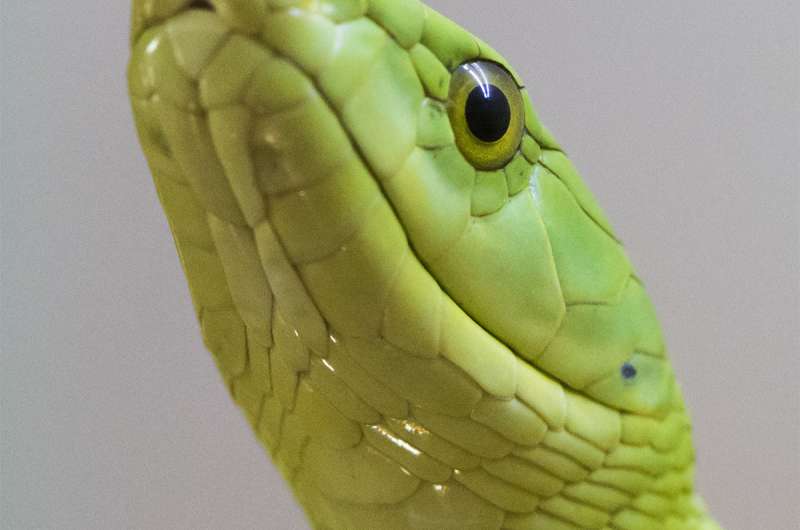The green mamba, Dendroaspis angusticeps. Credit: C. Vanbellingen
(Medical Xpress)—A team of researchers from France, Germany and Belgium has found that giving a peptide found in green mamba venom to mice with a kidney disease led to reduced symptoms. In their paper published in Proceedings of the National Academy of Sciences, the group describes how test mice with polycystic kidney disease (PKD) saw reduced symptoms when given the peptide.
PKD is a genetic disorder that causes kidney problems for people (and mice)—fluid-filled cysts develop, which can damage the kidneys leading to renal failure. Prior research has shown that, like many other disorders, PKD is actually a family of ailments caused by different problems in the genome. PKD is not curable and is treated with drugs called vasopressin antagonists that block the type 2 vasopressin receptors that cause the cysts. But such drugs have negative side effects, one of which is liver damage. In this new effort, the researchers studied the venom from a poisonous African snake because snake venom tends to do its destructive work by causing neural problems, some of which involve cell receptors.
To learn more about possible benefits of green mamba venom, the researchers isolated a peptide called mambaquaretin-1, which was known to block cell receptors. They gave it to six mice that had been genetically altered to have PKD over the course of 99 days. The mice were monitored to see if they suffered any ill effects from the peptide, and to find out if it had a positive impact on the kidney cysts in the mice. The researchers report that all of the mice given the peptide (as opposed to those given just salt water as a control) experienced improved kidney function and no side effects. They also found that the number of cysts in the treated mice was reduced by approximately one-third and total kidney area made up of cysts was lessened by 47 percent. A closer look suggested that the peptide caused such improvements by blocking the type-2 vasopressin receptor, just as current drugs are meant to do.
More research will have to be done, of course, to figure out if the peptide is safe for use in people and if it offers the same benefits, but as of now, the team is optimistic. They also plan to look into using the peptide to treat other ailments.
More information: Green mamba peptide targets type-2 vasopressin receptor against polycystic kidney disease, Proceedings of the National Academy of Sciences (2017). DOI: 10.1073/pnas.1620454114 , www.pnas.org/content/early/2017/06/13/1620454114
Abstract
Polycystic kidney diseases (PKDs) are genetic disorders that can cause renal failure and death in children and adults. Lowering cAMP in cystic tissues through the inhibition of the type-2 vasopressin receptor (V2R) constitutes a validated strategy to reduce disease progression. We identified a peptide from green mamba venom that exhibits nanomolar affinity for the V2R without any activity on 155 other G-protein–coupled receptors or on 15 ionic channels. Mambaquaretin-1 is a full antagonist of the V2R activation pathways studied: cAMP production, beta-arrestin interaction, and MAP kinase activity. This peptide adopts the Kunitz fold known to mostly act on potassium channels and serine proteases. Mambaquaretin-1 interacts selectively with the V2R through its first loop, in the same manner that aprotinin inhibits trypsin. Injected in mice, mambaquaretin-1 increases in a dose-dependent manner urine outflow with concomitant reduction of urine osmolality, indicating a purely aquaretic effect associated with the in vivo blockade of V2R. CD1-pcy/pcy mice, a juvenile model of PKD, daily treated with 13 μ
Journal information: Proceedings of the National Academy of Sciences
© 2017 Medical Xpress






















